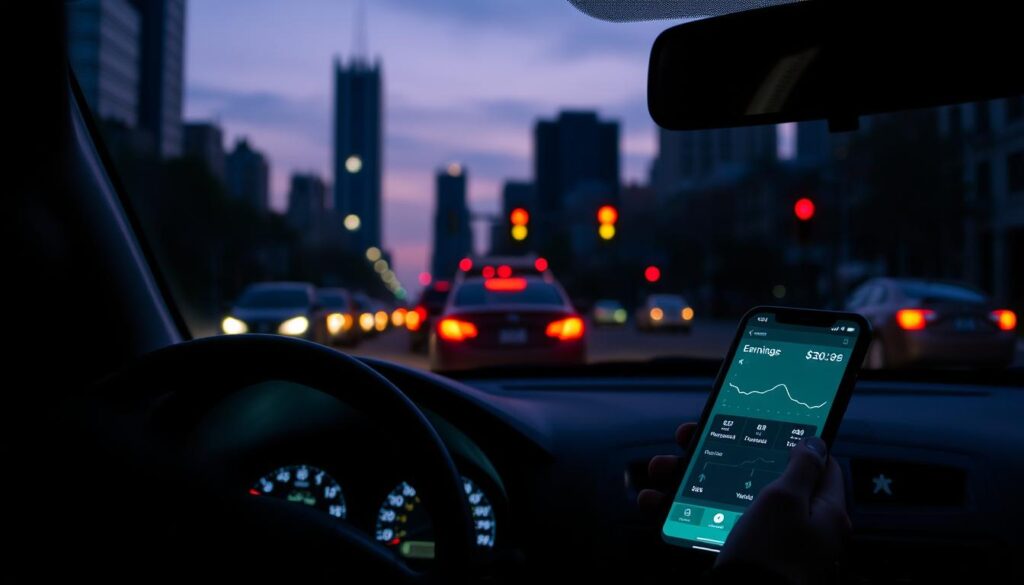
Thinking about joining the gig economy? You might wonder about the money you can make as a rideshare driver. Data from July 10, 2025, shows a worrying trend. Despite more drivers on Uber and Lyft, their earnings have dropped a lot in five years.
This drop is quite surprising. You’d think more drivers would mean more money. But, the truth is, rideshare driver income is going down. This makes it one of the worst side gigs in 2025.
Key Takeaways
- Earnings for Uber and Lyft drivers have decreased significantly.
- The number of drivers on these platforms has increased, leading to lower earnings.
- The gig economy is shifting, with driver pay being a major concern.
- Rideshare driver income is not keeping up with the rising cost of living.
- Alternative gig economy jobs may offer better financial prospects.
The Declining Reality of Uber and Lyft Driver Pay in2025

Uber and Lyft drivers are facing a tough time in 2025. Their take-home pay keeps going down. The gig economy, once seen as a way to make good money, is now hurting drivers’ earnings.
Gridwise data shows that many drivers earn less now than they did five years ago. This drop is due to more competition, higher costs, and changes in Uber and Lyft’s algorithms.
Current Earnings Statistics vs. Previous Years
Uber and Lyft drivers’ earnings are a big worry. Looking back, their pay has significantly decreased. In big cities, drivers now make less than they did a few years ago. This is despite the rising cost of living and expenses.
A study found that drivers’ average hourly pay has dropped by up to 30% from 2020. This big drop in income is hurting thousands of drivers’ lives.
The True Cost of Rideshare Driving: Expenses That Erode Your Profits
Driving for Uber or Lyft comes with many expenses. These include fuel costs, vehicle maintenance, insurance premiums, and depreciation. Many drivers don’t fully understand these costs, which can make their earnings seem higher than they really are.
Fuel costs alone can be a big expense, even more so in cities with high prices. Vehicle wear and tear also add to maintenance costs over time. When you add these up, drivers’ actual earnings are often much lower than they seem.
5 Critical Reasons Rideshare Driving Has Become Unsustainable

Rideshare driving used to be a good way to make money. Now, it’s hard to keep up financially. Knowing why can help you decide what to do next in the gig economy.
Oversaturation of Drivers in Major Markets
There are too many drivers in big cities. This means fewer rides for each driver. Your chances of making good money are lower.
- Increased competition among drivers
- Reduced ride requests per driver
- Longer wait times between rides
Algorithm Changes Reducing Driver Benefits and Ride Opportunities
Uber and Lyft keep changing their algorithms. These changes often hurt drivers. You might get fewer rides or earn less per ride.
Key impacts of algorithm changes include:
- Reduced visibility of high-paying ride opportunities
- Increased deactivation rates due to stricter performance metrics
- Changes in commission structures that affect your take-home pay
Rising Vehicle Maintenance, Depreciation, and Fuel Costs
Keeping a vehicle for rideshare driving costs more. Fuel, maintenance, and depreciation add up. These expenses make it harder to make money.
Some of the key expenses to consider are:
- Fuel costs, which can fluctuate with market prices
- Maintenance and repair costs, including regular servicing and unexpected repairs
- Depreciation, as your vehicle loses value over time
Increased Insurance Requirements and Premium Expenses
Insurance for rideshare drivers is now more expensive. You must pay more for coverage. This cuts into your earnings.
The impact of increased insurance costs is significant, as it directly affects your bottom line.
How Uber and Lyft Driver Pay in2025 Compares to Other Gig Work

The gig economy is growing fast. It’s important to compare Uber and Lyft driver pay in 2025 to other gig work. More platforms mean more choices, but which ones pay the best?
Food and Grocery Delivery Services
Services like DoorDash, Instacart, and Amazon Flex are getting popular. They offer flexible hours, which is great for extra money. But, how much you make depends on the service, where you are, and when you work.
DoorDash drivers can make $15 to $25 an hour. Instacart shoppers earn $12 to $20 an hour. Amazon Flex drivers can make $18 to $25 an hour. These rates are close to Uber and Lyft, but remember, fuel, maintenance, and car wear and tear can cut into your earnings.
Specialized Service Platforms
Platforms like TaskRabbit, Rover, and Fiverr offer special jobs. TaskRabbit lets you offer handyman services. Rover connects pet sitters with pet owners. Fiverr is for freelancers, from digital marketing to writing.
Earnings vary a lot. TaskRabbit taskers can earn $20 to $50 an hour. Rover pet sitters make $15 to $30 an hour. Fiverr freelancers can earn $5 to $100 an hour or more, based on their skills and services.
Real Hourly Earnings After Expenses: Cross-Platform Comparison
To really see how Uber and Lyft compare, we need to look at earnings after expenses. The table below shows average hourly earnings for different gig economy platforms, minus expenses.
| Platform | Average Hourly Earnings | Average Hourly Expenses | Real Hourly Earnings |
|---|---|---|---|
| Uber | $18-$25 | $5-$7 | $11-$18 |
| Lyft | $17-$24 | $5-$7 | $10-$17 |
| DoorDash | $15-$25 | $4-$6 | $9-$19 |
| Instacart | $12-$20 | $3-$5 | $7-$15 |
| TaskRabbit | $20-$50 | $2-$4 | $16-$46 |
| Fiverr | $5-$100+ | $0-$2 | $5-$100+ |
When looking at gig economy jobs, remember to think about expenses and real earnings. Uber and Lyft can be good, but other platforms might pay more, depending on your skills and what you offer.
Top 6 Better Alternatives for Former Rideshare Drivers

If you used to drive for Uber or Lyft, you’re not alone. The gig economy has grown, and many drivers are looking for new gigs. These gigs might offer better pay, more stability, or a fresh start.
Luxury and Specialized Transportation Services
Luxury car services are a great alternative to regular ridesharing. They serve high-end clients who pay more for comfort and reliability. Companies like Blacklane and GetTransfer offer these opportunities.
Specialized services, like medical transport, also provide stable work. They need drivers for non-emergency medical trips.
Industry-Specific Delivery Opportunities
Delivery services for specific industries are another good choice. Medical delivery services transport samples and equipment. Legal document delivery services move sensitive documents between law firms and courts.
Catering and food delivery services, focusing on high-end or specialty food, can also be profitable. These gigs often pay more and are less crowded.
Vehicle-Based Side Hustles Beyond Passenger Transport
There are many side hustles you can do with your vehicle. You can offer mobile advertising by wrapping your car in ads. Or, you can try mobile billboard advertising with a large ad on your vehicle.
You can also rent out your car on Turo. These options let you use your vehicle for income and might earn you more than ridesharing.
Exploring these alternatives can help you find better gigs. They offer higher earnings and more flexibility. By trying different gigs, you can find what works best for you.
The Quality of Life Factor: Beyond Just the Money
Rideshare driving affects more than just your wallet. It’s important to think about how it impacts your overall well-being. When deciding if you should drive for Uber or Lyft, consider the quality of life aspects.
Safety Concerns and Passenger Interactions in 2025
Safety is a big deal for rideshare drivers. With more people using ride-hailing services, there are more reports of unsafe interactions with passengers. You should know the risks and take steps to stay safe.
- Use in-app safety features like emergency buttons.
- Be careful when talking to passengers, even at night or in quiet places.
- Lock your car when waiting for or driving passengers.
Most rideshare drivers feel safe, but some face harassment or unsafe situations. It’s key to be aware of these risks and take action to avoid them.
Schedule Flexibility vs. Unpredictable Earnings
One big plus of rideshare driving is schedule flexibility. You can pick your hours, fitting work around other things. But, this flexibility means your earnings can be unpredictable.
- Your pay can change a lot due to demand, time, and other factors.
- Income can vary from week to week, making budgeting hard.
- Busy times or special events might mean more money, but it’s not always the case.
To manage your money well, understand that your earnings will not always be the same. Be ready for changes and plan your finances carefully.
Long-Term Career Development and Skills Acquisition
Driving for Uber or Lyft might be just a temporary job or a side gig. But, think about how it affects your career long-term. The skills you gain, like customer service and time management, can help in other jobs.
“The skills I’ve developed as a rideshare driver have been invaluable in my other professional pursuits.” – John, former Uber driver
But, many drivers don’t see much career growth or benefits. Think about whether the long-term benefits outweigh the challenges of rideshare driving.
When exploring the gig economy, look beyond just the money. Consider how rideshare driving fits with your long-term goals and dreams.
Conclusion: Making Smarter Choices in the Evolving Gig Economy
The gig economy is changing fast. Uber and Lyft driver pay in 2025 is not enough to cover costs. It’s time to think about better choices.
Drivers are earning less and spending more. This makes it hard to keep up with living costs. Looking for new ways to earn is key.
Exploring other jobs online can help. This includes food delivery or special transport services. It’s a chance to earn more and have a better career.
FAQ
What is the current state of Uber and Lyft driver pay in 2025?
How do Uber and Lyft driver earnings compare to other gig work in 2025?
What are the main expenses that reduce Uber and Lyft driver profits?
Are there alternative gigs that former Uber and Lyft drivers can consider?
How do safety concerns and passenger interactions affect Uber and Lyft drivers?
What is the outlook for gig economy income projections in the transportation industry?
Can Uber and Lyft drivers improve their earnings by working during peak hours?
What are some strategies for Uber and Lyft drivers to make smarter choices in the evolving gig economy?
Share :
You Might Also Like







